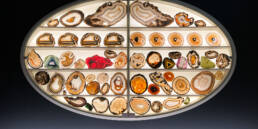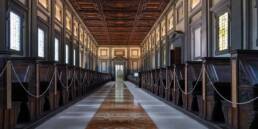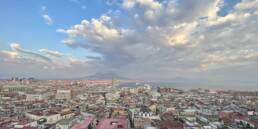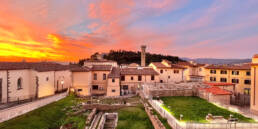The end of 2023 and the beginning of 2024 has seen enough important Florence Museum news to warrant a dedicated article. From the opening of the municipal collection’s deposits to an all-new Orsanmichele with extended opening hours, here’s what is happening in Florence’s museums this year.
Turnover at state museums
In 2014, then-minister of culture Dario Franceschini opened an international call for directors of the 20 most important state-run museums in Italy who were given independent status, allowing for the direct management of funds and faster decision-making for changes. In Florence, the respected scholar Cristina Acidini, who was director of all the Florentine state museums (Uffizi, Accademia and Bargello) was deposed in favour of the winners of this call. Since then we’ve heard a lot about Eike Schmidt, director of the Uffizi Museums (which also includes Palazzo Pitti) from 2015 to 2023 during which time the museum path was extended with numerous new rooms and displays; at the end of his 8-year term, he’s been moved to Naples, though rumour has it he might run for mayor of Florence. Paola d’Agostino also has to leave her post as director of the Bargello Museums, a group that extends to Orsanmichele, the Medici Chapels and Palazzo Davanzati, and where we’ll see she made extensive positive changes. The Bargello has an interim directorate, while on January 17, 2024, the Uffizi welcomed a new director, Simone Verde, a 48 year old art historian from Rome.
Re-Opening of Orsanmichele

January 2024 was full of major museum news with the reopening of the complex of Orsanmichele under the direction of the Bargello Museums. The museum was closed for 400 days and an investment of 1.1M euro was used to renovate the building and create a new display.
The first floor display puts the 13 sculptures originally in niches on the outside of the building in relation to their original locations on the façade; they are now elevated elevates them on a stand, with a neutral background to remove distractions. The sculptures are those by Lorenzo Ghiberti (San Giovanni Battista, Santo Stefano and San Matteo), Donatello (San Marco e San Pietro), Nanni di Banco (Sant’Eligio, San Filippo, Quattro Santi Coronati), Andrea del Verrocchio (The Doubting of San Tommaso), Baccio da Montelupo (San Giovanni Evangelista), Giambologna (San Luca), and the earlier Piero di Giovanni Tedesco (Madonna della Rosa) and Niccolò di Pietro Lamberti (San Giacomo Maggiore).






Rest assured that the sculptures are spaced sufficiently from their backdrops to see their backs, which of course in the niches we could not see, but it’s fun to get up into their skirts and see the rough bronze work or the shortcuts taken (such as a foot without a leg). What’s quite brilliant is that on the inside of the display, into which you can walk, dark grey panels contain a line-drawing of the relative sculpture’s niche, as well as all the information about the sculpture. This is a wonderful way to involve a lot of wall text that is optional for visitors. It also extends the visit if you do want to read everything, making it worth the entry ticket. Up an additional steep staircase you reach the top floor of the ex-granary with its 360 degree view over the city. We visited on a late winter’s afternoon and it had the most wonderful light! Here the biggest change is that they finally washed the windows… unfortunately, they’ll dirty quickly and I guess they are very hard to clean. They also have an inordinate number of very red fire extinguishers that assault this photographer’s eye; presumably there is a huge fire risk up here?
Previously, the upper floors of this museum were one of my hidden secrets: it was only open on Mondays, and was free, managed by volunteers. Now, it will be open on a more regular schedule like the rest of the museums of the group. Until March 12, the museum will be open every day from Monday to Saturday, 8:30 to 18:30, and on Sunday mornings 8:30 to 13:30. Tickets are now €8 for adults, 2€ reduced rate. Normally, and after March 12, the weekly closing day is Tuesday, but the hours have been extended to accommodate the surge of visitors to the new space. It’s handy to note that these opening hours make Orsanmichele still one of the museums in Florence open on Mondays!
Bargello: Bernini, medals and ivories
Director Paola d’Agostini was very busy towards the end of her stay at the Bargello, where she instituted more changes in the past few years than I think have been made in as long as I’ve been here and perhaps longer. I recently revisited the museum and was thrilled to see that the position of sculptures in the Donatello room has been altered for even better comparison amongst works; Verrocchio’s David had already been moved down here when he was restored in 2002, if I’m not wrong, where he returned in 2004 after traveling to the USA. The Verrocchio and the Donatello Attis-Amor, also in bronze and just a little bit smaller, now flank Donatello’s Bronze David, while on the vertical axis from the room’s entry, we have three Donatello sculptures all lined up – the Marzocco, Bronze David, and Saint George. I was unable to find out exactly when this final display was arranged (perhaps related to the Donatello exhibit in collaboration with Palazzo Strozzi two years ago?) but I found it very exciting.

The real news in recent months is the new displays of the ivories and bronze medal collections (revealed in late November 2023), which are now in beautifully lit, modern glass cases. For a Renaissance nerd, the bronze portrait medals are brilliant to see in their double-sided case; with a portrait on one side and an emblem on the reverse, these are pre-modern Facebook, used as tools of personal branding.

Finally, there is a new room behind that of the bronze coins dedicated to Baroque sculpture. And here, a total masterpiece that never really found a place within the mostly Renaissance collection: Gianlorenzo Bernini’s bust of Costanza Bonarelli (1630s). This “headshot” of Bernini’s lover (who was the wife of one of his assistants) was probably given to Cardinal Giovan Carlo de’ Medici by the artist himself.
Michelangelo’s Secret Room

At the Medici Chapels, late last year they instituted a regular opening of tiny “secret room” off the New Sacristy in which, scholars hypothesize, Michelangelo hid in 1530. He was hiding from the fury of Pope Clement VII, who had recently returned to Florence after a 3-year Republican break from Medici rule, and who had it in for Michelangelo because the artist worked for the government on city fortifications. He was in the bad books for about two months, during which he was apparently hidden in this room that measures 10×3 meters. To pass the time, as one does, he sketched ideas for the project he was working on, under which he was hiding.
The room was discovered in 1975 but due to its size, for preservation concerns, it wasn’t regularly opened to the public. A first slot of visits was released last November spanning the following 3 months and it sold out in minutes. A second slot opened up on January 25, 2024, and sold out in 3 hours. Another month has been added, but for now, it’s impossible to get in. Only 4 adults per slot are permitted inside for a maximum of 100 people per week, and it costs €32.
Opening of Florentine Civic Museums Depository

Florence has a brand new museum space, which is something that doesn’t happen every year. The newly created depository of the Florentine Musei Civici (Civic Museums) is located in the Santa Maria Novella complex, which gained extra space for culture with the closure of the “Scuola dei Marescialli” (don’t worry, those Carabinieri have a new home close to the airport). With time, some 4500 works of art will be made visible to the public in this space, which keeps them in optimal conditions while making it possible to observe them thanks to a system of moving walls, similar to library stacks, and in the future there will be drawers and other forms of interactive access. The 1100 square meter space is laid out on three floors, with sculptures on the ground floor and 650 square meters of space on the first floor divided into nine rooms.
The civic collections are composed of various nuclei, so to kick things off, about 300 works from the collection of the Museo Novecento including the Alberto della Ragione collection are hung, a collection whose main names include Fontana, Guttuso, Carrà, De Pisis, Mafai, Cagli, Morandi, if those ring a bell for you. In the future, we’ll see further 19th– and 20th– century works, paintings by the Macchiaioli movement, and of the Renaissance period, the sinopia of the Green Cloister of Santa Maria Novella, which at the moment are partially on display at the Santa Maria Novella Museum next door in what I now presume is a temporary arrangement.
Currently, access is through guided tours on Saturday mornings at 10, 11 and noon, and tickets cost €6. Booking is necessary through MUSE, the company that runs the civic museums, at +39 055 2768224, info@musefirenze.it.
H-Zero Museum gets a café

The opening of a new train-themed café with a delicious fusion menu proved the occasion for me to finally visit H-Zero Museum in the Santa Maria Novella area, now in its second year of life. This is a fun attraction for families and for geeky train enthusiasts, or anyone just looking for a different experience in the centro. A warehouse-sized model train world is the centerpiece of this attraction, representing 40 years of work by the Marquis Giuseppe Paternò Castello di San Giuliano and some of his model-train-building friends.
What began as a small collection turned into a huge project that literally was built in a warehouse in Scandicci, outside Florence, and what you see up top is just the tip of the iceberg vs. the complex mechanisms built into the raised structure of the model world. Having secured the former Ariston cinema adjacent to the Museo Novecento, the model was carefully cut into pieces and transported at night to the new location. The train world is complemented by immersive wall projections and music that take you through seasons and times of day, replete with an ASMR train “track”. A whole team of engineers, model builders and electricians work to keep the trains running around the clock, more or less on time. For more info and to visit, see www.hzero.com.
More museum news to look forward to in 2024
Apparently this strong start to the year is in fact just the start – we have two or three more important openings to look forward to before the summer. The museum of natural history and zoology, “La Specola” will be reopening on February 21, 2024 [read my review]. The museum has been closed for renovation since 2019 so we expect great things. If you’ve ever been, you know that this is the collection of “stuffed animals” and wax anatomies that were displayed in historic wooden cases. There will be a larger display area and services, and one assumes that the display will be updated as well.

There are plans for the opening of the MUNDI “Museo nazonale dell’Italiano”, the 5,5 milion euro investment to be the first big museum dedicated to the Italian language. It promises an interactive exhibition, audiovisual elements, projections and timelines as well as original documents and books. MUNDI will join the Depository in the newly recovered spaces of Santa Maria Novella. We can expect this new museum and some of the associated spaces in the SMN Complex to be presented before the mandate of Mayor Dario Nardella comes to an end this summer.
The Alinari archives are to be hosted in the Santa Maria Complex, making one wonder if and where they might finally reopen their museum which used to be in the building currently used as the Museo Novecento. Talks are underway between the region, which controls the archive, and the city, which controls the space, according to a January 2024 article in La Nazione.
Upcoming exhibition wise, as usual we don’t quite know what to expect in 2024 as only Palazzo Strozzi has announced theirs in a timely manner. Once again I’m disappointed that the Renaissance is a thing of the past, literally, for the major exhibition space, which will be putting on monographic modern shows dedicated to Anselm Keifer (March 11 to July 21 2024) and Helen Frankenthaler (September 27 2024 to January 26, 2025). The Uffizi has opened an exhibition of their most important Ancient statuary, “Divina Simulacra, Capolavori di scultura classica della galleria” (until June 30, 2024).
Sign up to receive future blog posts by email
Alexandra Korey
Alexandra Korey aka @arttrav on social media, is a Florence-based writer and digital consultant. Her blog, ArtTrav has been online since 2004.
Related Posts
January 5, 2024
The Architecture of Michelangelo’s Laurentian Library
September 11, 2023
An art historian’s approach to things to do in Naples, Italy
July 19, 2023




